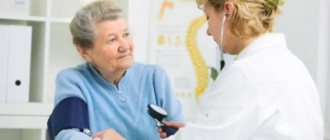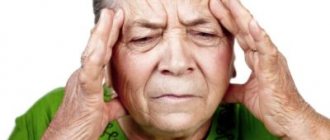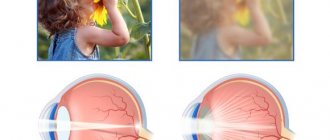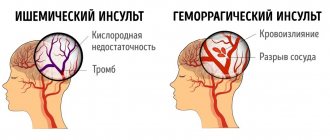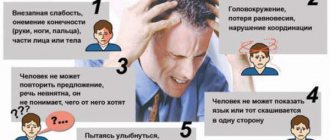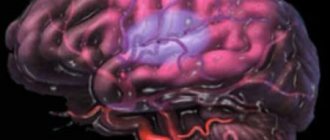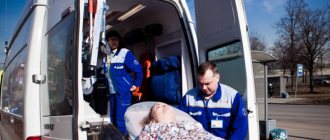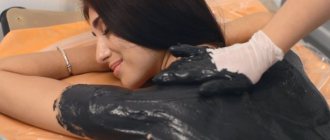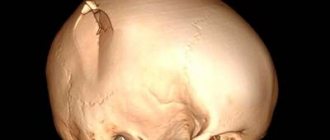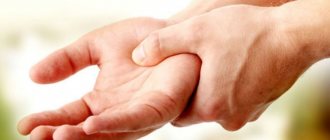Currently, a huge problem is not only mortality from strokes, but also a high percentage of disability. Rehabilitation for people who have suffered a stroke is very important, as it can reduce this percentage, as well as reduce the depth of neurological deficit.
Rehabilitation measures can reduce the patient’s dependence on outsiders, which improves his quality of life and is also important for his relatives.
In this article we will look at what exactly the consequences of a stroke may be, and what opportunities exist for their correction. You will become aware of the benefits of undergoing rehabilitation measures in a hospital, as well as what contraindications exist for this and what you can do at home.
Neuroplasticity or why you can recover after a stroke
The goal of neurorehabilitation is restoration or, in the absence of the possibility of complete recovery, partial compensation of impaired functions of the nervous system.
This is based on complex mechanisms of neuroplasticity. Neuroplasticity is the ability of nervous tissue to undergo restructuring following damage.
It should be remembered that the area of the brain that was damaged as a result of an ischemic or hemorrhagic stroke is not restored. Those nerve cells that have died will not recover. New neurons also do not appear. Therefore, restoration is possible only due to the fact that other neurons take over the function of the lost ones. This occurs due to those neurons located near the lesion in which irreversible changes have not occurred. This process is long, during which time various changes occur both at the structural and biochemical levels. It is also necessary to take into account that in case of severe damage to the brain, complete recovery should not be expected, since the capabilities of neurons for neuroplasticity are not unlimited.
It is believed that these processes can continue throughout the year after a stroke, most actively in the first months. Therefore, rehabilitation measures should begin as early as possible, even in the acute period of a stroke, already in the first days, as far as the patient’s condition allows.
Text of the book “Life after a stroke. A real experience of recovery after a “strike”, accessible to everyone!”
Sergey Vikentievich Kuznetsov Life after a stroke
From the author Why did I write this book and how to read it?
This book was written by a man who suffered a severe stroke, which initially led to group 2 disability with complete incapacity for work.
Thanks to the competent and comprehensive use of medicinal and physiotherapy methods, alternative methods of treatment and psychological methods of influence, the author managed to restore his body in a fairly short time. The book is intended for those who want to get a loved one back on their feet or are trying to get up themselves after a severe stroke, who want to do everything with their own hands, walk independently and communicate without interference.
This is not an entertaining book, and the questions raised in it can only be understood by someone who has been or is currently in the shoes of a stroke patient, or a person close to him. This book will be indispensable for anyone who has just suffered a severe stroke, is confused, depressed, does not know what or how to do, starting literally from the first days, hours, weeks, months or a year after the incident. It will help you avoid the first mistakes when restoring your health, because it contains valuable advice that is very difficult to get in real life. This book will also give hope to those who feel the despair of the futility of their efforts long after a stroke.
After reading it, you will learn about what a stroke is, its consequences, the first stages of treatment, the most effective techniques and ways to restore health after a stroke. This book also provides advice on caring for a sick person, on dressing and undressing, moving, treating with herbs and fruits, restoring speech and motor functions of the limbs, etc. Most of the tips contained in the book do not require large financial outlays and are calculated for those for whom medical care is inaccessible due to cost, or those who live far from large medical centers.
The author of the book sought, using the example of his own recovery, relying on advice received from medical specialists, to help people in a similar situation, as well as their loved ones, overcome the consequences of a stroke as quickly and effectively as possible.
Treatment after a stroke is not just a sequence of taking medications, injections, acupuncture sessions, massages, physical therapy and other physical procedures, which is described in detail in the book. It is also a new worldview, understanding of the world and perception of oneself and one’s body, one’s new role in life and in society. This is a comprehensive and at the same time integral philosophy of success, a philosophy of effective restoration of health, and it requires not a quick glance through the pages, but careful and thoughtful reading.
Preface
You or someone close to you has had, or, as doctors say, developed, a stroke. Most likely, up to this point, the body has informed you about malfunctions in its work, as, for example, a special light signals the driver about malfunctions in the cooling system of a car. You weren’t in a hurry to fix the problem, you weren’t in a hurry to see the doctor, hoping to “get there in one piece.” It’s too late to talk about how you should have behaved and taken care of your health - don’t blame yourself for anything. Yes, what happened is a terrible retribution for your carelessness and arrogance, but it’s too late to engage in self-flagellation. At the moment, it is more important to switch from searching for the causes of a stroke to the task of quickly and effectively restoring health after the incident. At the same time, you should understand that you have a long and difficult path ahead. Stock up on the desire to recover and patience, get ready for new hard daily work. Now this is your new job, your new profession, if you like. This is precisely a recovery period, and not a time of vacation, lying in bed, doing nothing or forced rest.
Create a daily routine and try to stick to it. Believe me, it will be very dense and rich, and at times difficult to complete. Treat exercises, water procedures, working with massagers, etc. as daily, hard, but necessary work. Do not give in to despair if the desired result does not come as quickly as you would like.
I developed a severe hemorrhagic stroke. The brain lesion area was approximately the size of a chicken egg. For shallow hemorrhage, neurosurgery could help. However, in my case, due to non-superficial hemorrhage, it would not have given positive results, so I was left with only drug treatment.
As a result of the stroke, I developed paralysis (hemiparesis) of my right arm and right leg, damage to the facial nerve and speech, deviation (recession, deviation) of the tongue to the right, motor aphasia, dementia, hearing and vision deteriorated, and contractures developed. For the first month after the incident, I could not lift my arm or leg or move the fingers of my right hand or toe. Doctors' forecasts after a month of treatment were disappointing. It was assumed that I would spend six months in a lying position, and then all my life I would walk with the help of a crutch or a cane, dragging my right leg, and my right arm would forever remain inoperative, hanging like a whip.
Only after a month and a half did I begin to sit up in bed, and at about the same time I moved my right thumb for the first time. This day was the most joyful for my loved ones after the stroke. Having a weak leg and a weak arm, using a four-legged cane, I began to take the first uncertain steps with an unruly leg across the hospital room and then down the corridor. After 4 months, my relatives brought me for a medical and social examination (MSEC). My condition was such that without any bribes, cronyism, degree of steepness, without any preparation of the question or preliminary persuasion, the members of the medical and social expert commission who saw me for the first time immediately assigned me the 2nd group of disability and the 3rd degree of restriction work activity (“completely disabled and in need of outside help”). The doctors officially assessed the prognosis for my possible recovery as unlikely.
And now - I ask for your special attention! Nine months after the stroke, I took my first test drive in my car at my own risk. Another month later, under the control of a second driver, I made the first non-stop motor rally along the busy M4 Don highway, covering a distance of 360 km in 5 hours.
Currently, I drive a car boldly and confidently, perform complex maneuvers in conditions of ice, traffic jams and heavy traffic in a city with a population of one million, and almost every month I make non-stop road trips of 400 km at a fairly high average speed (more than 80 km per hour). It goes without saying that I completely take care of myself and don’t need outside help. And you can understand how my memory and brain work by reading this book, written and typed by me personally on a computer keyboard.
The above confirms that, despite the gloomy medical prognosis, it is possible to quickly and effectively restore health after a stroke.
I agree with the well-known truth that stroke is a little-understood disease that occurs as a result of damage to parts of the brain. This is due to the fact that only 40% of the human brain has been studied by doctors. From a scientific point of view, it is used by the body only 20%. How the remaining 60% of the brain works and why a person carries the unused 80% of the brain in his own head, no one yet knows for sure. The interconnection of neurons in the head, the neuroplasticity of the brain, and its ability to heal itself are also a complete mystery. It is virtually unknown how to treat brain damage. Each time, treatment occurs, one might say, empirically, in an attempt to influence the hidden areas of this organ.
In this regard, many doctors shy away from specific answers to questions about restoring the health of their patients. The most typical answer: “Some things will be restored, but some will not. All the will of God". None of them gives detailed and complete advice and recommendations. It is quite difficult to find a doctor who will competently provide treatment in the first hours and days after a stroke. But an even bigger problem is to find a specialist in rehabilitation and health restoration after a stroke who could monitor changes in your body and adjust the rehabilitation process.
There is little hope for polyclinics, including elite ones, and for the activities of neurologists within the framework of dispensary registration and officially established time intervals for polyclinic appointments. Many followers of Hippocrates also do not shine with knowledge about the latest achievements of pharmaceuticals and the peculiarities of the use of new medicines and modern medical equipment. The overwhelming majority of “luminaries” of medical science turn out to be specialists in acute conditions and can give valuable recommendations mainly during the period of the “therapeutic window” (I will talk about this term in more detail later), in the acute and acute post-stroke periods. Finding a specialist who is truly ready to give practical advice on the patient’s recovery in the acute and later post-stroke periods is extremely rare.
Automation of the work of health workers, unification and coding of diseases according to the ICD and other modern approaches and shortcomings of publicly available formalized medicine do not contribute to this.
As a result, the stroke victim or people close to him begin to collect knowledge and various recommendations for self-healing on the side and bit by bit. However, such advice from non-specialists can also be harmful to health. For example, a victim of an ischemic stroke may not be suitable for treatment of hemorrhagic stroke at all.
I talked a lot with neurologists, doctors of the highest category, scientists and practicing specialists in the field of neurorehabilitation, on their advice I read and studied a lot of specialized literature, applied and experienced various techniques for recovery after a stroke, which gave a positive effect. That is why I decided to help other people in a similar situation. I think that my advice and recommendations will not disagree with the opinion of experts. In this book I will describe the methods of my recovery, including the nature of drug treatment.
Most of these tips are universal in nature and are suitable for all types of stroke. But medicinal and physiotherapeutic effects should be used only after consultation with attending physicians and specialists in the field of neurorehabilitation.
In my book, I tried to talk popularly and clearly about stroke, the mechanism of this disease, and the necessary steps to restore the body after a stroke. You may find comparisons, explanations and conclusions in it that are somewhat different from those officially recognized. I tried to understand and clarify complex phenomena and terms described in multi-volume medical encyclopedias, translating them into language understandable to ordinary people.
Unfortunately, it is impossible to cover all the materials on this topic in one book. It will not be possible to describe in detail, for example, all the physical therapy exercises, massage techniques, self-hypnosis and auto-training, features of dialogue with your body and much more that I used in my treatment and that could be a great help for you. But what is presented here is enough to successfully begin to comprehend the wisdom of recovery after what happened. First, let's talk in detail about the stroke itself and its possible consequences.
Chapter 1 What you need to know about stroke
What it is?
So, you or someone close to you has had a stroke. What is this and why did this happen to you?
In ancient times in Rus' they talked about this condition - “I had enough of a stroke”, “I grabbed a stroke”, later they began to call it an apoplexy.
Now let me introduce a few medical concepts here. You may find this a little tedious, not particularly educational and overloaded with special medical terms, but anyone who has had a stroke needs to know this. I will try to present the material as I understood and comprehended it myself after long conversations with doctors.
So let's get started.
Stroke (from Latin Insulto
- “I’m jumping”, “I’m jumping”), or a brain stroke, is an acute violation of cerebral circulation in hypertension, atherosclerosis and some other diseases. This is a very dangerous condition that causes hemorrhage in the brain or blockage of a cerebral vessel by a blood clot, developing suddenly due to acute cerebrovascular accident and persisting for at least a day.
The most common risk factors for stroke are:
• genetic predisposition to vascular diseases of the brain;
• hypertonic disease;
• insufficient physical activity;
• disorders of fat metabolism and (or) obesity;
• smoking;
• the age of the patient as such;
• stress and prolonged neuropsychic overstrain.
When two or more unfavorable factors are combined, the predisposition to stroke increases.
Most often, a stroke occurs with hypertension, with symptomatic arterial hypertension caused by kidney pathology, cerebral atherosclerosis, diseases of the blood, endocrine organs, rheumatism and vasculitis, intoxication.
The cause of a stroke can be hypertension itself (80–85% of cases). Less commonly, hemorrhages are caused by atherosclerosis, blood diseases, inflammatory changes in cerebral vessels, intoxication, vitamin deficiencies and other reasons. The vessels changed in these conditions are especially sensitive to physical and mental stress. Emotional factors, especially negative ones, can also lead to the development of a stroke.
Types of strokes
Based on the nature of changes in the brain, strokes are divided into two large groups: hemorrhagic and ischemic.
To hemorrhagic stroke
include hemorrhage into the substance of the brain or under its membranes (subarachnoid hemorrhage). Hemorrhages usually result from a rupture of a cerebral vessel caused by high blood pressure. In young people, the cause of a hemorrhagic stroke can be the rupture of a congenital aneurysm - a sac-like protrusion of the thinned wall of a blood vessel. It was this aneurysm that caused the sudden death of artist Andrei Mironov, who died during a performance on stage.
Cause of ischemic stroke
on the contrary, there is insufficient blood flow to certain parts of the brain due to narrowing or complete blockage of the blood vessels feeding them.
Sometimes a combination of these two types of strokes occurs.
How does a hemorrhagic stroke develop
? Without going into terminology or going into detail, let’s take a closer look at hemorrhagic stroke.
or
cerebral hemorrhage.
Most often, hemorrhagic stroke occurs between the ages of 45 and 60 years. It is usually preceded by hypertension, cerebral atherosclerosis or a combination of these diseases, arterial symptomatic hypertension, blood diseases, etc. Precursors of the disease (feeling hot, increased headache, blurred vision) are rare. Typically, a hemorrhagic stroke develops suddenly, against the background of emotional or physical stress.
The simultaneous development of spasm of many vascular branches in combination with the penetration of blood into the medulla can lead to the formation of an extensive focus of hemorrhage, and sometimes multiple hemorrhagic foci.
To better understand the mechanism of development of this disease, remember that the blood supply to the brain is carried out by a complex system of blood vessels.
Blood flows to the brain through four large arteries: two carotid and two vertebral arteries (extracranial arteries). Atherosclerosis of these arteries, that is, thickening and hardening of the artery walls, can significantly impair blood circulation through them, which in turn affects blood supply and brain function. In addition to extracranial vessels, atherosclerosis can also develop in the intracranial vessels of the brain, which directly supply brain tissue. I note that atherosclerosis of the intracranial arteries is a factor in the increased risk of stroke or intracranial (intracerebral) bleeding.
The consequences of the development of atherosclerosis of the cerebral arteries can manifest themselves in the form of episodes of ischemic attack: decreased sensitivity in half of the body, disturbances in movement, speech, vision, and hearing. In the future, against the background of severe cerebral atherosclerosis, there may be disorders of higher nervous activity (decreased memory and intellectual abilities), sleep disturbances, character changes (such a person becomes capricious, picky), and depression may develop. Without prevention and treatment, multiple cerebral atherosclerosis can lead to dementia (senile dementia) - a severe and difficult to reverse decline in higher brain functions. But the main danger of cerebral atherosclerosis is the possibility of developing a stroke.
We will find out further what are the first external signs of a developed stroke, its consequences and what should be the first actions of a person after he has suffered a stroke.
What can a stroke lead to?
In Russia, stroke affects 400–450 thousand people every year. According to rough estimates, every minute a new case of stroke occurs in our country. Moreover, about 35% of such cases end in death in the acute period of the disease. About 40% of stroke survivors die within the next month. Mortality from stroke has increased by 18% over the past 15 years, reaching 280 people per 100 thousand population.
Among surviving patients, more than half do not regain independence at home, and almost 80% permanently lose their ability to work. No more than 20% of patients return to work after a stroke. Stroke today remains the second (after coronary heart disease) cause of death and ranks first as a cause of permanent disability. A third of the sick are people of working age. In addition, stroke is one of the most common causes of dementia, depression and epilepsy in older people. Every fifth person is at risk of having another stroke within a year.
It is known that in Russia stroke is getting younger, that is, the number of victims of apoplexy is growing due to the fact that there are still quite young people under the age of 45. The number of cases of stroke in children and people under 20 years of age is increasing. The ratio of ischemic to hemorrhagic strokes is approximately 4:1.
These are sad statistics. How to minimize the negative consequences of a stroke?
The most important thing is the correct, timely and complete diagnosis of a developed stroke.
Delayed diagnosis and incomplete treatment in the first days of a stroke will significantly complicate the treatment process in the future and lengthen recovery time.
How to recognize a stroke
Before a stroke, a person may experience dizziness, a sudden severe headache and hot flashes to the head, numbness in the limbs, speech impairment, followed by loss of consciousness. Often the victim’s face becomes purple-red, the pulse is tense and slow, breathing is deep, frequent, often wheezing, the temperature rises, and the pupils do not respond to light.
External signs of a stroke include, individually or collectively: sudden weakness or loss of sensation in the face, arm or leg, or on one side of the body, sudden blurred vision in one or both eyes or loss of vision areas, difficulty speaking or understanding simple sentences, dizziness, loss of balance or coordination, especially when combined with other symptoms such as impaired speech, double vision, numbness or weakness, paralysis (hemiparesis) of a limb, damage to the facial nerve, and distortion (tightness) of the facial muscles to one side (facial asymmetry) , retraction (deviation) of the tongue to one side (deviation). Slurred speech and severe sensory loss are common, including lack of response to pain, cold, heat, or heat.
In most cases, the person usually lies on his back, his head and eyes are turned to one side, and his mouth is half open. The muscles of the body and limbs are relaxed; if you try to raise the patient’s arms, they immediately fall sluggishly down like whips. Skin sensitivity is usually completely absent, and the stroke victim does not respond to injections. The feeling is as if a person received a strong blow from a professional in the boxing ring.
Swallowing is sometimes difficult (dysphagia) after a stroke. In this case, in the first time after the development of a stroke, special probes and food thickeners are used to prevent food from entering the respiratory tract.
If vision zones are lost, a situation subsequently arises where a stroke victim eats only from one half of the plate, since he sees only part of it. It happens that a stroke victim looks at the hands of the clock, but cannot understand what time they show. He may also look at the keys and not understand which keys fit which lock. Cannot understand a map, city plan or area.
Memory is often severely affected. In this case, a stroke victim, for example, remembers everything that was before, but forgets new things. Sometimes he may forget words or knows them but cannot say them.
In general, there are many options for the external manifestation of the consequences of a stroke, depending on the zone (focus) of brain damage. I have described only the most common of them. In medical language, some of the clinical manifestations of a stroke will sound like contralateral limb weakness and (or) loss of sensitivity, aphasia, apraxia, dysarthria, partial or complete hemianopsia, disorders of consciousness and confusion, double vision, dizziness, nystagmus, ataxia.
It is worth noting here that, for example, speech, reading, writing, counting as activities are mainly under the control of the left hemisphere, and, for example, musical abilities are predominantly under the control of the right hemisphere. In most people, the left hemisphere has the ability for analytical activity - isolating individual features of an object (shape, size, color, quantitative parameters, etc.), comparing them with each other, and capturing the semantic features of concepts. The right hemisphere reflects reality in sensory images.
I had a stroke this morning. Up to this point, for a long time I worked not only during the main working hours - from 9 to 18 o'clock, but also in the evenings, almost every day until one in the morning, practically without days off. Fatigue was accumulating, but I perceived the heaviness in my head as a result of lack of sleep, and not an alarming symptom of a disorder in the vascular system.
The night before, I worked late as usual and didn’t fall asleep right away. In the morning I woke up with a feeling of heat in my head, the state was as if I, having slept for only half an hour, could not come to my senses. Getting out of bed with my left leg, I tried to take a step with my right, but I couldn’t. Losing my balance, I fell to the floor. Already lying down, I realized that neither my right leg nor my right arm, which looked completely lifeless, was listening to me. I began to scream, calling for help, but instead I could only utter a moo, although I tried to shout louder. About 10 minutes later, my mooing was accidentally heard by my daughter who came up to my room, after which panic began in the house, ending with an ambulance being called.
Restoring lost functions
The consequences of acute cerebrovascular accident can be different, depending on where the focus of the brain lesion is localized. If the centers responsible for movement are affected, the ability to move the limbs on the side opposite to the lesion will be completely or partially lost. If the speech center is damaged, speech will be impaired or may be completely absent. The same principle can be used to correlate all other neurological disorders that appear as a result of a stroke. Next, we will take a more specific look at possible neurological syndromes.
- Hemiparesis or hemiplegia is a disorder of motor function.
- Hemiparesis is a partial loss of strength in the limbs on one side (only on the right or only on the left).
- Hemiplegia is a complete loss of the ability to move the limbs on one side.
Impaired motor function may manifest as muscle weakness, leading to limited range of motion up to complete immobility in the affected limbs. In mild cases, impaired motor function may be manifested by awkwardness of movements and rapid fatigue.
Muscle atrophy may often develop in the affected limbs. This is due to the fact that the muscles of these limbs do not have the necessary load, as a result of which they atrophy, which complicates the rehabilitation process. Therefore, from the first weeks it is necessary to carry out active or passive gymnastics, if it is impossible to carry out active gymnastics due to deep paresis, cognitive impairment or impaired level of consciousness. The best option for carrying out such gymnastics is a physical therapy doctor.
Spasticity is also a motor dysfunction. This is an increase in muscle tone in the affected limbs. This aspect also requires attention, as it has a negative impact on the implementation of movements, restoration of walking and self-care.
With severe spasticity, the usual pathological position of the limb is formed. With increased muscle tone, it is difficult to straighten a limb or, for example, fingers. This also threatens the appearance of flexion contactures—limitation of passive movements in the joint. If this problem is identified, regular therapeutic exercises are necessary to prevent the formation of the usual position of the limb, for example, if, due to spasticity, the fingers of the hand are constantly bent, it is necessary to straighten them with a healthy hand or with the help of an outsider and fix them in this position. The use of orthoses is also effective.
In some cases, the attending physician may prescribe certain medications that help temporarily reduce increased muscle tone, but this will be ineffective or not effective at all if contractures have formed.
Most often, with a hemispheric stroke, restoration of movements occurs first in the lower limb, then in the upper, and most recently in the hand, this is due to the peculiarities of the blood supply to the brain. But this pattern is not 100 percent. Everything can be individual. Restoration of movements can begin already in the first days after a stroke. However, if there is no dynamics for a month, then the prognosis for further restoration of movements is very doubtful. The most effective time for motor rehabilitation is the first 3-6 months from the onset of a stroke.
Hemorrhagic and ischemic strokes: which one is more dangerous?
Hemorrhagic stroke accounts for about 20% of all stroke cases and is the most severe and dangerous, as it causes rupture of cerebral vessels, hemorrhage into the cranial cavity, development of hematoma and cerebral edema. Brain cell death occurs within minutes.
This type of stroke is fatal in 50-60% of cases. About 70% of survivors are at risk of remaining disabled. With this type, the critical days are considered to be the entire period from the moment of impact to 2 weeks after it. During this period the probability of death is highest.
Ischemic stroke is the most common type of stroke. It accounts for about 80% of cases. It is a violation of blood flow in any part of the brain due to blockage of blood vessels (the vessels remain intact). The blockage causes a severe lack of oxygen and nutrients in the brain cells, causing the cells to die. This type leads to the death of patients in 20% of cases.
Periods of stroke:
- Acute: first 4-5 hours.
- Acute: 14-20 days.
- Early recovery period: from 3 to 6 months.
- Late recovery period: from 6 months to a year.
- Period of long-term effects: 12 months from the onset of the attack.
Basic methods of motor rehabilitation
Physiotherapy
Therapeutic gymnastics includes physical exercises aimed at general training of the body, training tolerance to physical activity, as well as special exercises aimed at restoring lost functions.
A set of physical exercises performed by a physical therapy doctor is selected individually based on the motor deficit of a particular patient. The exercises are aimed at increasing muscle strength, increasing range of motion in joints, reducing muscle tone, improving coordination, learning to stand and walk.
Restoration of walking takes place in several stages: imitation of walking while lying down, sitting, learning to stand and maintain balance, learning to walk with a 4-support cane within the ward, learning to walk on stairs, walking outdoors. During the restoration of walking, an important point is the correct positioning of the foot. Often, as a result of a stroke, the ability to walk is lost; in this case, it is necessary to control the position of the foot, knee and hip joints. Physiotherapy doctors know how to do this correctly.
You should not expect that a person with profound impairment of motor functions will be able to walk immediately. This requires a long time, the work of specialists and the work of the patient himself. Restoring walking function is not always possible; it depends on many factors - from the motivation of the patient himself to the extent of brain damage. It is not uncommon to meet a person who, years later, still walks poorly after a stroke; often the deficit can persist for life. But rehabilitation helps reduce this deficit to the minimum possible.
Verticalization
Verticalization involves bringing the patient into an upright position as far as the motor deficit allows. The minimum level of verticalization is considered to be raising the head end of the bed. Next is a half-sitting position in bed, then a sitting position in bed, then sitting in a bed or chair with legs down. It is necessary to begin verticalization from the first days and continue it continuously if the general condition of the patient allows this.
The importance of these events is difficult to overestimate. When staying in a horizontal position for a long time, the muscles of the back and limbs do not work, the tone of the blood vessels changes, and the longer the patient is only in a horizontal position, the more difficult it will be in the future to teach him to sit and “accustom” his vessels to a vertical position.
Orthosis therapy
Orthosis therapy is the use of special fixing functional devices. They are necessary for temporary immobilization of individual segments of the musculoskeletal system. Effective in the treatment of contractures and to facilitate the restoration of movement and provide stability while improving gait function, for example to protect the knee or ankle joint. The need to use this method is determined by the physical therapy doctor.
Massage
Massage can help combat spasticity in the limbs, as well as improve tissue trophism. But this method is only auxiliary. Since it has been proven that those methods used in rehabilitation in which the patient does not actively participate have practically no effect.
Physiotherapy
Physiotherapy includes electrical stimulation. This method is used to prevent atrophy and reduce spasticity. Provides a training effect. This method will not teach muscles to contract voluntarily; it only prevents muscle tissue atrophy. This should not be assumed to restore movement.
Full or partial restoration of motor functions is possible with the joint work of the patient, physical therapy doctor and neurologist.
Exercises
The rehabilitation process should begin in the hospital a week after the attack, unless doctors see any contraindications. It is necessary to change the patient's position every two hours, otherwise stagnation of blood will lead to even more serious consequences.
Why can our articles be trusted?
We make health information clear, accessible and relevant.
- All articles are checked by practicing doctors.
- We take scientific literature and the latest research as a basis.
- We publish detailed articles that answer all questions.
While the patient is in a supine position, passive gymnastics can be performed. It begins with stroking and rubbing the hands and fingers, after which the wrist and elbow joints are bent and straightened, and moved to the shoulder area. Gymnastics of the lower extremities should also begin with the fingers and proceed to smoothing the femoral area.
To reduce muscle tone, massage is necessary. It will be better if an experienced massage therapist starts to perform it and teaches the basics to the patient’s relatives. It is important to maintain consistency and regularity of procedures - they must be daily, otherwise rehabilitation will take many months.
When the doctor allows, they move on to active activities. The exact list of rehabilitation exercises is selected by a rehabilitation physician based on the patient’s motor capabilities. During the rehabilitation period, this specialist must be visited regularly to adjust the recovery plan.
Hypoesthesia - loss of sensitivity
When the area of the brain responsible for sensitivity is damaged, hypoesthesia develops - a decrease in sensitivity. Its decrease will manifest itself in the limbs opposite to the side of the lesion.
Sensitivity, as a rule, takes longer to recover than movements in the limbs, this is due to the structural features of sensitive nerve fibers.
To restore sensitivity, tactile stimulation can be used - irritation with cold temperature, vibration, pressure. Therapeutic gymnastics also plays a certain role, promoting awareness of the position of the limb in space.
Coordination problems
When the cerebellum is damaged, coordination disorders develop - accuracy and consistency of movements. They can manifest themselves in different ways: impaired stability when standing or walking, impaired coordination of movements, tremor. A number of patients experience severe impairment of walking function due to damage to the cerebellum. In this case, the strength in the limbs can be completely preserved, the range of movements is full, but when performing purposeful actions (walking, standing up, trying to independently bring a spoon to the mouth), significant impairments are revealed.
Rehabilitation of such patients consists of motor activation, balance training, motor skills training, and fine motor skills training. A large role in solving this problem is given to therapeutic exercises. A special set of exercises is used aimed at:
- Increased precision of movements
- Improved coordination of movements
- Balance training and walking training
- Training fine motor skills and various hand grips
For concomitant dizziness, drug therapy is used to improve blood circulation in the brain and suppress the excitability of the vestibular centers. The drug, dose and dosage regimen are prescribed exclusively by a doctor.
Depression after an illness
A sudden stroke is a blow not only to the body, but also to the psyche. Often patients and their relatives become depressed. A person experiences despondency and anger because he has lost his usual skills, cannot work, support his family, or do what he loves. He becomes irritable and whiny, transmitting his mood to everyone around him. This affects his relationship with his family. It is difficult for them to get used to the new situation and be patient.
Depression after a stroke is common, affecting up to half of all patients. It appears both due to the psychological consequences of the disease and due to brain damage.
During this time, it is important to remember that most problems are real, but temporary. The quality and speed of rehabilitation depends on the patient’s mood. The patient and his relatives are recommended to consult with a psychologist. In severe cases, the doctor refers the patient to a psychiatrist for treatment with antidepressants. Remember that there is nothing wrong with this. Mental health is just as important as physical health.
And also read on our website: Stroke in children - causes and symptoms
Speech disorders
It is often possible to encounter the fact that a person does not speak after a stroke; speech disorders appear in most patients, to one degree or another. Speech disorders occur when the speech areas of the cerebral cortex, subcortical structures or pathways are damaged.
There are different types of such violations:
- Aphasia is a systemic disorder of speech activity that occurs when the speech center of the left hemisphere is damaged in right-handers and the right hemisphere in left-handers. Aphasia is often accompanied by impairments in writing (agraphia) and reading (alexia). Aphasias are also divided into several types; this article will indicate only the main, most common ones:
- Motor aphasia is a violation of speech activity, manifested in the difficulty or impossibility of pronouncing sounds, syllables, and words. Secondarily, it may be accompanied by a violation of understanding the speech of another person.
- Sensory aphasia is manifested by a violation of the discrimination of specific speech sounds, and, accordingly, is manifested by a lack of understanding of the speech of others. As a result, the patient answers the questions posed incorrectly, speech is disorganized, and consists of a set of unrelated words.
- Amnestic aphasia is a violation of the naming of objects; a person can describe why a given object exists, but does not remember its name.
- Dysarthria is a violation of the pronunciation of words due to insufficient innervation of the speech apparatus. The speech system does not collapse, but the clarity of sound pronunciation, articulation, phonation and intonation coloring of speech suffers. The disturbances can be severe to the point that others cannot understand the patient’s speech.
The rehabilitation of such patients should only be carried out by a professionally trained speech therapist. Specialists conduct correctional classes with such patients, selecting exercises individually based on the type of speech disorder. In some cases, “disinhibiting” and stimulation techniques are necessary, in others, on the contrary, it is necessary to slow down some processes. In parallel with speech restoration classes, reading and writing restoration exercises are also carried out. A speech therapist teaches correct articulation and speech understanding.
Gymnastics of the muscles of the pharynx and pharynx, articulatory muscles, massage of these muscles, and training in the coordination of respiratory movements can also be performed.
Rehabilitation measures to correct speech must begin as early as possible, even in the acute stage of the disease. This promotes faster speech recovery. You should be prepared for the fact that in case of severe violations, the restoration of speech function is a long process. If the patient does not speak after a stroke, then a lot of time will be required; recovery will not be limited to the time spent in the hospital, but will also require the involvement of specialists at the outpatient stage. Classes are possible at home or in a clinic with a frequency of at least 2-3 times a week.
Speech restoration
The loss of speech functions leads the patient to depression - the inability to communicate and express one’s desires is sometimes more difficult to bear than the loss of motor skills. Violation of formed speech is called aphasia, which is divided into several types.
The sooner treatment for aphasia begins, the greater the chance that speech will return to normal. It should be borne in mind that the age of the patient matters - in old age the likelihood of fully regaining speech skills is lower.
Treatment options for aphasia:
- Speech therapy – classes should be conducted by an experienced speech therapist. It’s good if relatives master several exercises and can do additional work with the patient.
- Physiotherapeutic – electrical stimulation of muscles in speech areas.
Stroke at a young age
Stroke is considered to be a pathology of older age.
The attending physician, having determined the area and degree of brain damage, can give an approximate prognosis and choose the most appropriate method of speech restoration. In any case, the patient’s stroke field should be shown to a speech therapist, who will draw up an articulation gymnastics program.
What exercises can you do on your own:
- Pull your lips forward, hold for 2-3 seconds, alternate with a wide smile.
- Alternately grab the upper and lower lips with your teeth and hold for 5 seconds.
- your tongue out as far as possible. Ideally, the tongue should be straight and sharp.
- Open your mouth, stick out your tongue a little, raise and lower, touching your lips.
- Mouth in a smile, move your tongue left and right, touching the corners of your lips.
- Alternately inflate and suck your cheeks back in.
- With your mouth closed, touch your cheeks with your tongue.
- If possible, pronounce syllables, words, sentences or tongue twisters.
Repeat each exercise 10 times, increasing the load over time. During classes, you should take into account the mood of the student and his desire to study; if the patient is in a bad mood, it is better to postpone classes and read books to him. Singing is useful for restoring speech. You can start by singing vowel sounds, gradually moving on to the patient’s favorite songs.
Swallowing disorders
Dysphagia is a violation of the act of swallowing, accompanied by choking when taking liquid or solid food.
This problem is very relevant for patients who have suffered a stroke, but it is not always given enough attention. A condition when a patient does not swallow after a stroke or swallows with difficulty is dangerous with a number of complications, which will be discussed below.
When the swallowing center is damaged, dysphagia of varying degrees occurs and requires different measures to correct the disorder and ensure patient safety.
Swallowing assessment should be performed in every stroke patient. In difficult cases, endoscopic techniques can be used to diagnose dysphagia.
In case of choking or any discomfort that occurs while drinking or eating, it is necessary to consult a specialist and select an individual diet.
The diet consists of a certain consistency of food suitable for a particular patient. When choking on the thickest food, a nasogastric tube is installed and feeding occurs only with its help. Special food mixtures are used. In this case, you should not take anything by mouth! The patient receives all food and drink only through a tube. In the absence of correction of the disorder, surgical techniques are used for a long time, and a gastrostomy tube is installed.
For moderate or mild swallowing disorders, the consistency of food and drink is selected and strictly observed. Soups can be in the form of cream or puree, drink in the form of jelly, if this consistency is suitable according to the results of an examination by a specialist. If necessary, special thickeners can be added to food to create a thicker consistency.
If you have dysphagia, you should never give regular liquid (water, tea, juice) without a thickener!
The great importance of this issue is associated with the possibility of drink and food getting into the respiratory tract - aspiration. Choking indicates aspiration.
Complications associated with dysphagia include:
- Tracheobronchitis
- Pneumonia
- Empyema of the lung
- Breathing problems
- Exhaustion, dehydration
- Sinusitis
In conditions of multiple stroke, especially if the patient’s condition does not allow him to actively move independently, the likelihood of inflammatory complications occurring is very high. That is why great attention should be paid to the nutrition of such patients. Cooking food for them should take into account the degree of dysphagia and be selected by a specialist.
Rehabilitation of patients with dysphagia does not have many possibilities. These include:
- Individual selection of food and liquid consistency.
- Exercises aimed at training the muscles of the pharynx, mouth, and larynx, which should be carried out by a specialist.
- Physiotherapy – electrical stimulation of the muscles involved in the act of swallowing.
The possibility of changing the consistency of food consumed is determined by the doctor or swallowing specialist, and not by the patient or his relatives!
Memory recovery
Most strokes are accompanied by memory impairment. The severity of the disorder depends on the area of the brain affected. In some patients, improvements become noticeable within a few weeks. Others require a longer recovery period.
For rehabilitation, a qualified speech pathologist-defectologist who has experience working with patients who have suffered a stroke is involved. The classes are aimed not only at restoring memory, but also at improving the quality of speech.
Exercises are selected individually, but there is a set of exercises suitable for each patient:
- Poems by heart For the first time, light children's quatrains are suitable. If successful, they move on to more complex poems.
- Finger games. Such activities stimulate the speech and memory areas of the brain. These include: lacing, unscrewing bottle caps, sorting cereals, as well as verses involving counting and bending fingers.
- Game of cities. Stimulates the thought process. You can exchange cities for any other items.
- Memorizing objects. 5-6 objects are placed on the table; they must be memorized in 10-15 seconds. Then the patient closes his eyes and one thing is removed. It is necessary to name what is missing. Over time, the number of items increases.
- Memorizing pictures. Paired pictures from children's books are suitable for this activity. The patient looks at the drawing, remembers it, and is asked to look at the second one. Usually in another picture other objects disappear or appear, the color of things changes.
It is useful for memory to recreate visual images. The patient can be asked to remember the names of pets from his childhood, what he was wearing when he met his friend, what he had for dinner a week ago. There are a lot of options; the support and imagination of relatives will help you quickly restore memory gaps.
Cognitive impairment
One of the consequences of a stroke is impaired cognitive function. The frequency and depth of such disorders correlates with the age of the patient. If a cerebrovascular accident occurs against the background of an existing cognitive deficit, then there will be a worsening of existing symptoms and, probably, the appearance of new ones.
Impaired cognitive functions include:
- Attention deficit, impaired ability to quickly orientate in a changing environment.
- Decreased memory, often short-term.
- Rapid exhaustion of mental processes.
- Slowness of thinking.
- Narrowing the range of interests.
There are 3 degrees of cognitive impairment:
- Mild degree – minimal cognitive deficit, the patient follows instructions, is oriented in place and space, controls his behavior, but there are disturbances in concentration, memorization of new material, and decreased mental performance.
- Moderate degree - orientation in place and space may be impaired, moderate decrease in working memory, errors in following two-step instructions.
- Severe degree - dementia. Severe impairments of memory, intelligence, attention, social maladjustment.
A neuropsychologist examines such patients more thoroughly and selects the necessary exercises to train memory and thinking for a particular patient. If necessary, anti-dementia drugs that require long-term use may be prescribed.
Emotional-volitional disorders - post-stroke depression
Depression is often one of the consequences of a stroke. Many relatives of patients consider this problem to be insignificant or deny its existence altogether; for them it is much more important that movements and speech are restored. But such an attitude to this problem entails consequences. Very often, against the background of depression, restoration of lost functions is slow, and exercises become ineffective. With depression, motivation decreases to the point of its complete absence, existing cognitive impairment intensifies, the patient cannot and does not want to understand tasks and instructions. The patient becomes adynamic and inhibited. With the passive participation of the patient, the effectiveness of rehabilitation is minimal.
Appetite may also decrease, but if the patient does not eat after a stroke, this leads to nutritional deficiency, which also complicates the rehabilitation process.
The cause of post-stroke depression can be either damage to certain areas of the brain or awareness of the depth of the problem with preserved criticism.
In this situation, not only the help of a psychologist is required, but also the use of antidepressants. The course of treatment should last at least 6 months.
Nutrition
Diet therapy is one of the important factors during the patient’s recovery period. A special table No. 10 has been developed for such people. The menu includes balanced food; consumption helps normalize blood circulation and blood pressure, and reduce the load on the cardiovascular system.
Following a special diet means:
- limiting salt ;
- reduction of cholesterol in the blood;
- reducing the calorie content of foods;
- inclusion of foods rich in magnesium and potassium.
Coma due to stroke
Coma that occurs during a stroke is recorded in medical practice in approximately 8-10% of cases.
In order for the patient to quickly get used to the new menu and not be bothered by the constant feeling of hunger, it is recommended to eat in small portions 4-5 times a day.
The diet must include:
- dried fruits;
- nuts;
- lean varieties of fish and meat;
- fresh vegetables and fruits;
- cereals;
- vegetable oils.
All dishes must be steamed, baked, boiled or stewed.
To prevent the formation of atherosclerotic plaques, it is necessary to completely avoid sour cream, canned food, smoked meats, sausages, sweets, alcoholic beverages, and fatty meats.
This diet is not short-term. She must always be present in the life of a patient who has suffered a stroke.
Occupational therapy
Ergotherapy is an area of physical rehabilitation that helps a person adapt to environmental conditions, as well as restore movements in the upper limbs, by working with special exercise equipment and game tasks (constructors, mosaics, “laces”). Also, the task of the occupational therapist is to teach lost everyday skills.
A person who has suffered a stroke and has insufficient strength and range of motion in the hand is limited in everyday activities, which negatively affects the quality of his life. Therefore, restoring the functions of the upper limb, and especially the hand, is one of the most important tasks.
The ergotherapist teaches the skill of dressing independently; this is possible even with complete absence of movement in one hand. She also teaches how to eat; cutlery and dishes are adapted for such patients. They learn everyday hygiene skills - washing, shaving, brushing teeth. Using familiar objects also requires attention - a mobile phone, a pen (learning to write, practicing handwriting), an iron, a remote control. Training is carried out taking into account the capabilities of each patient. Occupational therapy allows the patient to adapt to environmental conditions, taking into account the existing neurological deficit, which reduces dependence on others and improves the quality of life.
Exercises for a stroke survivor
A person who has had a stroke should try to do the exercises on their own, because... his future life depends on it. Muscles and joints need movement to stay in shape. And mental exercises will help the brain recover faster.
Exercises for a person who has had a stroke:
- Train your facial muscles in front of the mirror: puff out your cheeks, push air from one cheek to the other, stretch out your tongue, show your teeth, smile, laugh, wrinkle your forehead.
- Flexion-extension, rotation of the limbs, clenching the hand into a fist, swinging the arms and legs. Be careful not to overtire the person.
- If a person used to love to sing, then try to sing with him. Some people can sing after a stroke even if they cannot speak because singing and speaking are controlled by different parts of the brain.
- Breathing exercises. Exhale air through closed lips or through a straw into the water. As your strength increases, you can try inflating balloons.
- Talk and discuss the news, ask for his opinion.
Pain syndrome
Sometimes you may encounter a complaint that after a stroke a paralyzed arm hurts or a paralyzed leg hurts. Pain can be either central in origin or due to the formation of contractures. If in the first case only certain types of drugs prescribed by a doctor can help, then the formation of contractures can be prevented by early initiation of exercise therapy. If contractures begin to form, then it is necessary to continue physical therapy or begin, if for some reason, exercise therapy was not started earlier. In free time from exercise, the patient himself or his relatives can passively make movements in the joints where the contracture is formed, this will help get rid of it more quickly.
Recovery time
Each patient after a stroke requires a certain amount of time to recover. With extensive damage, rehabilitation may take more than one year, and with serious motor disorders, minor defects may remain.
Recovery after an ischemic stroke can be divided into periods:
- Acute – the first month after the attack.
- Early – up to six months after a stroke.
- Late – rehabilitation period from 6 to 12 months.
- Residual – recovery lasting more than a year.
Extensive hemorrhagic and ischemic stroke often leads to paralysis and disability. The consequences of a hemorrhagic stroke can be more severe than an ischemic stroke, and rehabilitation may require a long period of up to 2 years or more.
The most positive prognosis is for those patients whose condition progresses rapidly in the acute and early period. The later improvements become noticeable, the more likely it is that noticeable effects of the stroke will remain.
